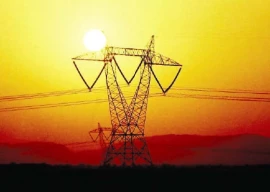
ISLAMABAD:
To mitigate the risks of floods due to glacier lake outbursts in the northern areas, the Ministry of National Disaster Management on Monday launched a two-year pilot project to help local communities adapt to the growing pressures of climatic change.
The project, titled “Reducing Risks and Vulnerabilities from Glacier Lake Outburst Floods (GLOF) in Northern Pakistan”, is the first of its kind that aims to enable vulnerable communities by developing human and technical capacities of public institutions.
While speaking at the seminar held on occasion of the project launch, experts said that the measures will help the communities better understand and respond to GLOF risks. Representatives of the project’s cosponsors, UNDP and Adaptation fund, also attended the seminar.
The northern areas are home to 5,218 glaciers, 2420 glacial lakes, and 52 lakes that have been classified as potentially dangerous. However, given the lack of resources, the pilot project will primarily focus on developing the capacities of communities settled on the breaches of the two most vulnerable lakes in Gilgit-Baltistan (G-B), said Muhammad Javed Malik, the secretary of Ministry of National Disaster Management.
The two selected lakes are located in Bagrot valley and Drongagh valley - the former houses an estimated 1,100 households and 10,000 people, and the latter is home to an estimated 500 households with a population of almost 3,500 people. The lake in Bagrot valley is at a distance of 35kms from Gilgit city, while the lake in Drongagh valley is at a distance of 40 kms from Chitral municipality.
Malik said the frequency of GLOFs has increased with time, adding that they can occur due to a host of factors – such as soil erosion, build-up of water pressure, avalanche of rock or heavy snow, earthquake or volcanic eruption under the ice, and massive water displacement due to a large portion of the glacier breaking off. As glaciers retreat, glacial lakes form behind moraine or ice dams, he explained.
The secretary said that due to inherent instability of such dams the potential of sudden outbursts or breaches is extremely high. The outbursts release millions of cubic meters of water and debris in a few hours, with flows as high as 15,000 cubic meters per second.
The flooding is usually up to hundreds of kilometres, resulting in a large number of displaced persons.
According to government statistics, Hindu Kush-Himalayan region contains 15,000 glaciers and cradles nine major river systems. As a result of rapidly changing climatic conditions, the glaciers of Pakistan are receding at a rate of almost 40 to 60 meters per decade. In 2005, it was identified that there is one potentially dangerous glacier lake in Chitral and eight potentially dangerous glacier lakes in Gilgit.
Malik said that the government is now cautioned on the effects of GLOF and have recently approved a climate change policy. “This is our life line. We need to protect our national treasures,” Malik added.
Deputy Director UNDP Douglas Hageman said that Pakistan realises the urgency of adapting to climate change and UNDP has been supporting it since 1996.
Published in The Express Tribune, April 17th, 2012.
COMMENTS (2)
Comments are moderated and generally will be posted if they are on-topic and not abusive.
For more information, please see our Comments FAQ



































































Hope this project don't die as other projects in the past.
Global Warming Is a Global Warning!!!